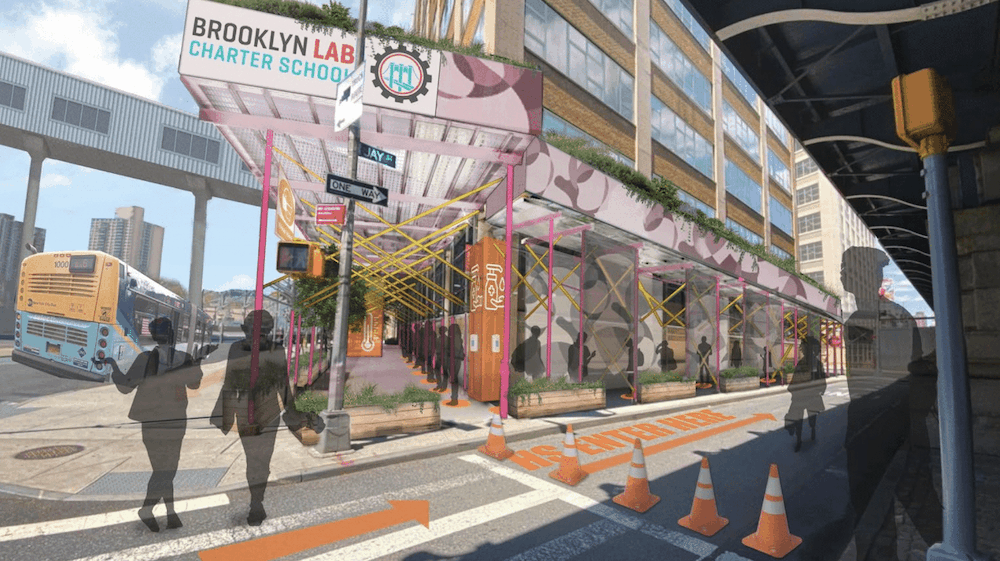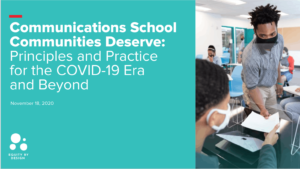Safeguarding Back to School: Preparation for a Healthy Return to School in Downtown Brooklyn

Image Credit: SITU
The transition back to school this year will be unlike any in history. Guidance and rules are still being refined and released, and school communities understandably feel anxious and tentative about reopening safely. We are deeply aware of our obligation as educators to safeguard the health, safety, and welfare of everyone in our school community—from our students, staff, and teachers to all of their families.
As leaders of an urban public school, Brooklyn Laboratory Charter Schools (LAB), we understand that schools operating in dense built environments with limited points of entry and classroom space will face unique challenges with new requirements for operations and facilities. LAB has begun to design a Back to School Facility Tool Kit with ideas for addressing health, safety, and the requirement for social distancing. Importantly, our tool kit embeds equity at the core; we want to create a plan that meets the needs of our diverse student population and staff, particularly students with disabilities.
No school has the time or resources to tackle all of these challenges alone, and at LAB, we are excited about the opportunity to collaborate. Part of our contribution as a laboratory school is to create an adaptable tool kit that can be used by other schools. To that end, we are sharing our reopening plan with organizations including the Educating All Learners Alliance in the hopes of reaching special education, technology, and educational organizations that can tailor these resources for their own use. We are creating this tool kit to support planning for the Brooklyn LAB school building at 77 Sands.
First and foremost, our reopening plan will align with the recommendations of the American Federation of Teachers’ (AFT), which include:
- Maintaining physical distancing.
- Putting the infrastructure and resources in place to test, trace, and isolate new cases.
- Deploying the public health tools that prevent the spread of the virus and aligning those tools with education strategies that meet students’ needs.
- Involving workers, unions, parents, and communities in all planning.
- Investing in recovery.
Beyond these requirements, we have set additional goals for our tool kit. It must be:
- Applicable to all students, especially students with disabilities.
- Practical and feasible to implement
- Flexible and easy to adapt to ever-changing circumstances.
- Modifiable for use by other schools in other contexts.
Over the past two weeks, LAB has collaborated with several design firms, school community members, and a range of experts to develop a series of design ideas that will be considered for inclusion in our tool kit. During the next stage in this process, we will continue to refine the design ideas and begin to build mock-ups to test what works and what requires further refinement.
We are now sharing version 1 (V1) of our tool kit in order to start a conversation and share a range of perspectives about how facilities interventions can support the safe reopening of school buildings. We are sharing these design ideas now, before they are finalized, so that we can benefit from critical feedback from students, families, and staff.
ABOUT OUR V1 BACK TO SCHOOL FACILITIES TOOL KIT
Version one (V1) of our toolkit seeks to address complexities and offer a specific working example of how to honor public health guidance in logistical planning. To prevent viral transmission, we must coordinate facilities planning, educational approaches, and public health approaches into a single, unified plan. That plan will evolve as the available facts and data change.
V1 focuses on ideas to address two major needs:
- Mapping a safeguarded journey from home to the school. The first set of ideas responds to the needs of families, students, staff members, and community stakeholders about maintaining health and safety from the time individuals leave their front doors through the arrival and entry process at school. This first step in the mapping process took into consideration the very real entry and egress challenges LAB and many other schools face.
- Upgrading the classrooms. The second set of ideas focuses on practical and feasible remapping of classrooms, breakout rooms, and common spaces to comply with social distancing requirements.
Please remember that this version is still a draft. LAB Chief Operating Officer Aaron Daly describes V1 as a starting point for our community to begin discussions and further iteration. “It explores the plausibility of particular approaches to reopening,” he explains. This working example also aims to address group questions about feasibility, workability, and effectiveness of specific approaches.
For V1, we are looking to engage teachers, families, and students before we begin the next step to further refine our tool kit. We are inviting you to engage in one of five ways, depending on what makes the most sense for you:
- Provide your feedback via a survey, so that our planning process can benefit from your insights, concerns, and recommendations.
- Register for a focus group conversation.
- Attend a webinar, which will include the AFT, design team members, and Brooklyn LAB teachers and educators.
- Share the V1 tool kit with leaders in your school community, to consider the relevance of questions and solutions developed in relation to the Brooklyn LAB facility to your own context.
- Email to offer input or propose ways we might work together to move this agenda forward in communities around the country.
ABOUT THE DESIGN PROCESS
We developed our V1 tool kit through a collaborative design “charette” that allowed us to listen to and incorporate insights from a range of stakeholders, including families, public health experts, students, teachers, parents, guardians, and peer schools.
To conduct this charrette, LAB partnered with leaders in urban design, including Urban Projects Collaborative (UPC), a firm dedicate to capital projects that improve quality of life and the build environment, and five design firms: Gensler, PBDW, PSF Projects, SITU, and WXY. The charrette process included the following steps:
- LAB teachers, special educators, case managers, deans, operations leaders, and administrators met with UPC in initial sessions to identify challenges reflecting student, staff, and family concerns related to their experiences with school closure and their concerns about safety protocols in future reopening.
- Five design firms agreed to bring their best thinking to the table to brainstorm ideas and preliminary designs to address the back-to-school challenge.
- The five firms held additional work sessions with LAB staff to home in on components of the challenges that they were best equipped to address, taking into consideration emerging state and public health guidance.
- The design firms developed concepts based on identified needs and anticipating what are likely to be appropriate practices to address social-distancing and other health-related requirements.
This process allowed us to hear from individual members of our community whose lived experiences are important to consider in our solutions. For instance, LAB special educator Anisa Phillip raised questions about what social distancing would look like for students with profound autism and intellectual disabilities. “How can we safely provide physical assistance to students who require support while walking?” she asked. “How do we keep masks on students at all times?”
Asking these specific questions about the needs of individual students and staff ground the re-entry planning process in the realities of our school community. “This version emphasizes the process of working through the challenge of re-entry,” says LAB Chief Financial Officer Sheryl Gomez. “The annotated examples and contextual framing establish a starting point, from which students, families, and staff are invited to engage and provide feedback.”
NEXT STEPS
The next step in this process is to review and further develop these ideas. We are now gathering input from LAB students and families, and we are working with relevant authorities to ensure that every design idea we implement addresses occupancy and air-quality requirements, as well as hygiene protocols. In parallel, we are assessing these ideas for feasibility based on budget and schedule constraints. In recognition that guidance on opening schools may change if there’s a resurgence of the virus, we are also working to test how to smoothly transition from plans for in-school learning to remote learning.
We will continue to monitor and adjust our tool kit over the next 18 to 24 months. As we do, we’ll prioritize the most vulnerable students and put equity at the core of the design work. There may be waves of stopping and starting, progress and backsliding, and developments that change assumptions.
“Throughout this process, we must integrate the concerns of the most vulnerable students into every aspect of preparation, while regularly seeking to understand family concerns, needs, and experiences,” emphasizes Cecile Kidd, LAB’s bursar. “We must focus on preparation, and thus build the muscles we need to adapt, refine, and determine priorities appropriately.”
We are encouraged by our community involvement thus far; we know that as we work together, we will get closer to creating a safe reopening that works for all.
For more, see:
- To Reopen, America Needs Laboratory Schools
- Preparing to Reopen: Six Principles That Put Equity at the Core
- How to Reopen Schools: A 10-Point Plan Putting Equity at the Center
- Podcast: Eric Tucker on Reopening Schools with Equity in Mind
- Educating All Learners During COVID-19: An Alliance Emerges to Provide Support for Virtual Special Education Services
Stay in-the-know with innovations in learning by signing up for the weekly Smart Update.
Getting Smart has launched the Getting Through series to support educators, leaders, and families on the path forward during such an uncertain time. This series will provide resources and inspiration as we face long term school closures, new learning environments, and address equity and access from a new lens. Whether you are just getting started with distance or online learning, or you’ve had plans in place and have the opportunity to share your work and guidance with others, there is a place for your voice and an opportunity to learn.
We’re going to get through this together, and we invite you to join us. Please email [email protected] with any questions or content you’d like considered for publication. We also invite you to join the conversation and on social media using #GettingThrough.








Cennia Keem
You might consider incorporating an after school program for building with Legos and doing Lego robotics. There is a man in Brooklyn who has the classes designed for after school and for video transmission. His name is Nathaniel Meek and his website is ideasStudio kids.com